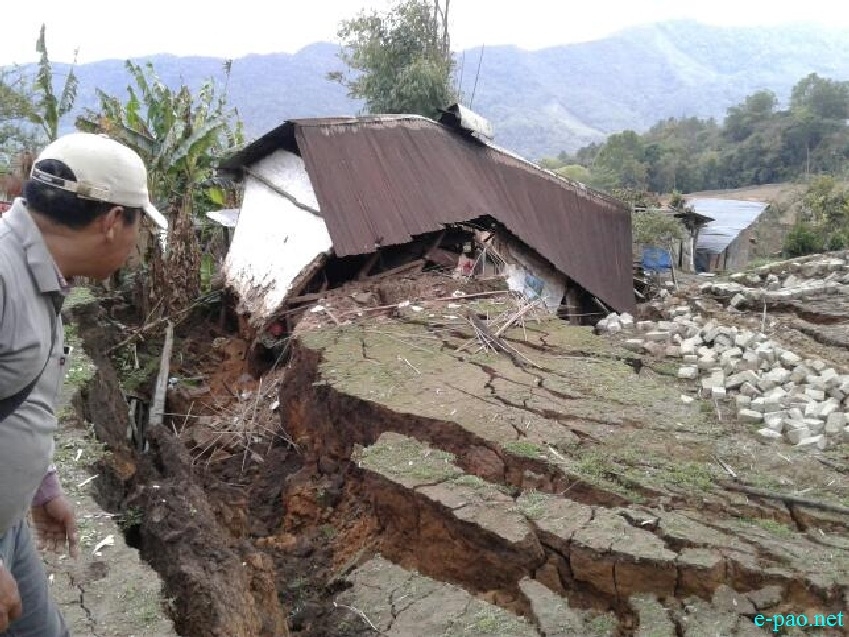
Landslide has been a major disaster commonly faced by the north eastern states including our state Manipur since time immemorial. The earliest recorded disastrous landslide in the NER region was on 19th August, 1950 (killing > 500 lives) which was the aftershock effect of the Great Assam earthquake (~8.6 Mw) that was recorded on 15th August, 1950. Since then innumerable landslides have been occurring claiming lives, domesticated animals, building/structure collapses, blockage of highways, roads, damage to the natural slopes which ultimately hampers the socio-economic development in the region. In spite of the government’s attempt to mitigate or so to say reduce the effect of this natural disaster, the landslide still happens to be periodic havoc till date. News of frequent disturbances, blockage of national highways, even human and livestock deaths are prime time in most of the news channels, print media, etc. during monsoon season.
It is estimated that economic loss due to landslides may reach between 1-2% of the gross national product in many developing countries. Evaluating and mitigating the landslide hazard and risk is a major challenge for the technocrats and decision makers in the developing world as 80% of the reported fatalities due to landslide is within the developing countries. In India, about 0.42 million sq. km or 12.6% of land area, excluding the snow covered area, is prone to landslide hazard. Out of this, 0.18 million sq. km falls in North East Himalaya, including Darjeeling and Sikkim Himalaya; 0.14 million sq. km falls in North West Himalaya (Uttarakhand, Himachal Pradesh and Jammu & Kashmir); 0.09 million sq. km in Western Ghats and Konkan hills (Tamil Nadu, Kerala, Karnataka, Goa and Maharashtra) and 0.01 million sq. km in Eastern Ghats of Aruku area in Andhra Pradesh. The landslide-prone Himalayan terrain falls in the maximum earthquake-prone zones (Zone-IV and V) where earthquakes of Modified Mercalli intensity VIII to IX can occur, and thus, are also prone to earthquake-triggered landslides. The most recent example is the aftermath of 18 September 2011 Sikkim Earthquake in the Sikkim-Darjeeling Himalayas.
When viewed scientifically a number of technical causes for landslides come up. The end number of scientific causes may be classed into geological factors, morpho-physiological factors, and factors related with anthropogenic activity. The geological factors may be elaborated into materials affected by geological structures-disconformities, joints, fissures; weathering effects, rainfall-snowfall impacts; earthquakes; mechanical (engineering) properties of materials-permeability contrast, material contrast. The morpho-physiological causes include slope angle, different erosional processes, slope loading, vegetation changes, hydrological condition, etc. The anthropogenic activity will contagiously include all possible changes in the environment that directly or indirectly affect the slope. Construction projects roads-buildings-tunnels, Quarrying-mining-blasting; deforestation are few to be listed that directly affect the slope.
Remedial methods may be like, strengthening the material, geometrical modification to slope, support system- breast wall, retaining wall, drainage control. Though the causes are manifold, for each and every cause, perfect or accurate scientific solutions are available nowadays. But these solutions are a vague to consider the economic input that is required. This can be elaborated by an example to remedial a landslide that subsided a bamboo hut located on the edge of Imphal-Moreh road at Tengoupal by geo technical solution say- excavating the overburden slope, drainage to divert excess water, it may sometime be economically cheap to allocate a new plot to construct a new hut with full compensation.
Critical reason for landslide management comes up as landslide is often causes by a combination of a number of causes. Hence prioritization of each causes need to be assessed. This part is to be dealt by specific agencies that have enough human and technological strength. But it cannot cover all the parts of the hilly parts of the state or even the length of the important national and state highways at a go. That is why we still are not able to cope up the wrath of the landslides. State disaster department when dealing with the landslides at Noneh-Kotlen to protect the National Highway, people are dying in Tamenglong district due to landslide. The point is that the government can’t provide all out technical measures to solve the landslide issue in every nook and corner of the state.
As rainfall is unmanageable or to rectify the faulty geological parameters by geo engineering projects are costly, it may seem that there is no possible cure for the problem. But as the saying goes, something is better than nothing, we should now react ourselves to that something mode instead of the present nothing mode. When unity can defeat any sort of obstacle, there is nothing impossible. Only we need to act as an organised mechanism against this natural disaster. An effective mode of awareness to the persons utilizing the slopes by the state government is inevitable going parallel with the scientific hunt to prevent landslides. The ground level persons, viz. the people who are constructing houses on the hill slopes are should be educated about the simple use of safety measures while utilizing the slopes. Brief brochures, publicity on the first hand information of landslide needs to be propagated. Or simply the local or the district administration can devise to develop early warning system during peak rainy seasons (Darjeeling and East Sikkim districts have already devise an early warning system for landslides). Such measures are very cost effective comparing with those huge scientific researches where funding is involved. No doubt, faithful scientific researches for landslide susceptibility for huge and specific developmental projects like National Sports University, National Highway Projects, Railway tracts and tunnels should compulsorily be done by the authority.



